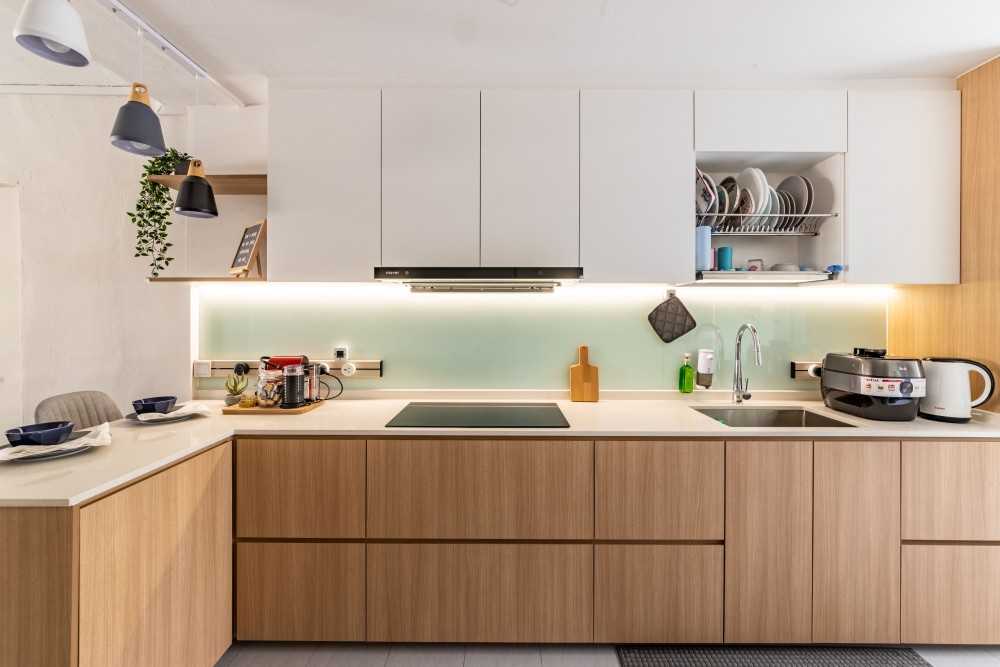How To Design a Home That’s Perfect For Hosting
In Singapore, where apartment spaces are limited, designing a home for hosting requires strategic planning. However, with the right design choices, even a small apartment can be transformed into a welcoming and practical space for all kinds of gatherings.
Whether you’re planning cozy get-togethers or kids’ playdates, here’s a guide to creating a home that’s perfect for hosting.
Choose an Apartment Layout Ideal for Hosting
When selecting an apartment, the layout can make all the difference in how easily you’ll be able to host. While design elements can help maximize any space, the right layout will naturally support gatherings, making hosting more enjoyable and less of a logistical challenge.
Here are some tips to keep in mind:
First, opt for a squarish layout. A squarish or compact floor plan creates a central hub for guests to mingle and interact, unlike long, linear layouts that can feel segmented and awkward for socializing.
In a linear layout where spaces are set up in a row (e.g., kitchen, dining, and living areas), it can be challenging for guests to move and gather comfortably. This layout may also separate guests, making the gathering feel less cohesive.
Next, prioritize open floor plans. Open layouts that combine the kitchen, living, and dining areas are ideal for hosting. They allow conversations to flow naturally across the space, enabling you to cook, serve, and entertain without barriers.
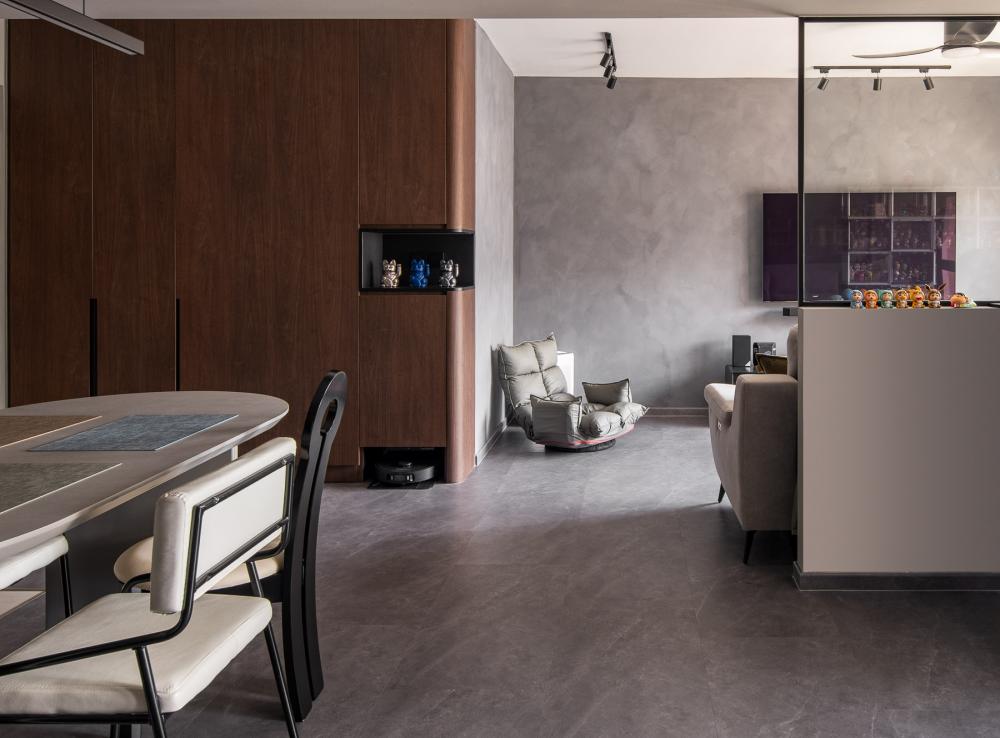

123B Tengah Dr ($85,000) by Mr Designer Studio
Next, maximize natural light. Look for layouts with good window placement in the main living areas. Natural light creates a warm, inviting atmosphere and can make the apartment feel more spacious, which is always a plus for hosting.
Last but not least, balcony or large windows are a plus. If available, a balcony or large windows in the living area adds an open, airy vibe. Fresh air and an outdoor view can elevate the space, making it more comfortable for guests.
Create a Multi-Functional Living Area
Once you have the right layout, it’s time to think about how you’ll furnish and arrange your main living area to make it as versatile as possible. In small spaces, multi-functional design is essential for hosting with ease.
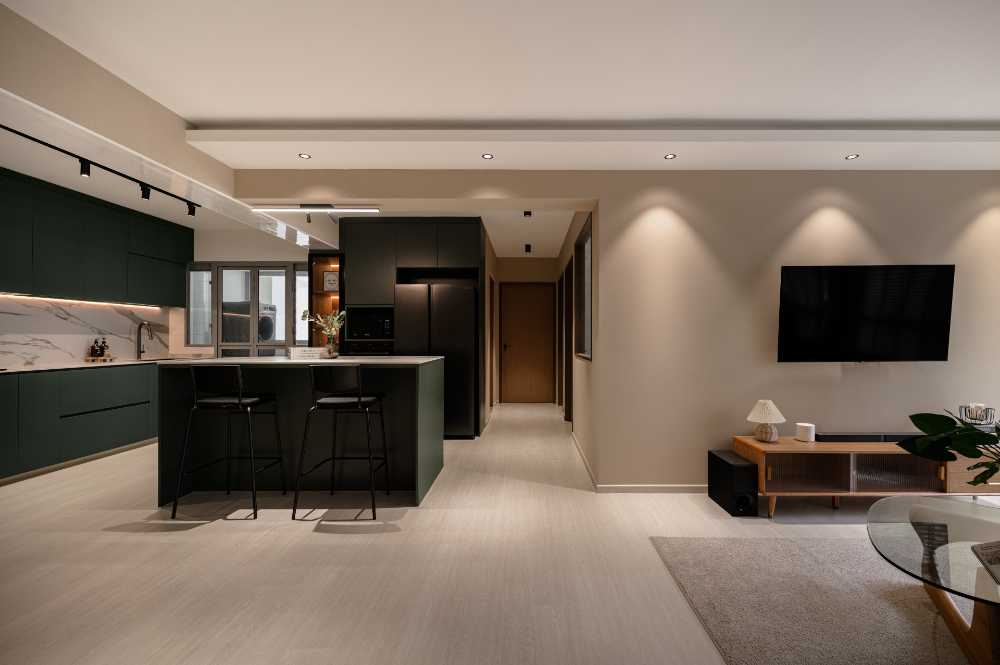

Waterway Sunrise 1 ($90,000) by PRDT Pte Ltd
Utilize an open layout for flexibility
We’ve talked about how open floor plans allow conversations to flow naturally across your space. On top of that, they also maximize the usable floor area, create a sense of openness and freedom, and make the space feel larger than it actually is.
- Blend living and dining for a larger gathering space. By merging the living and dining areas, you create a cohesive, expansive area that’s well-suited for gatherings. This approach allows for a more spacious environment where guests can move freely, rather than feeling confined to one spot. It also eliminates the boundaries that often make spaces feel smaller.
- Use area rugs or low partitions to define zones. If you still want some visual separation, use a large area rug under the sofa to delineate the living space from the dining area, or incorporate a low open shelf that can serve as both storage and a subtle divider.
- Arrange furniture in an appropriate way. Arrange furniture to facilitate natural flow, creating pathways that guide guests from the entrance to the main social area without obstruction. Placing seating in a way that keeps it open on at least two sides will make it easy to add or rearrange pieces based on the occasion.
Modular and Convertible Furniture
Investing in modular, multi-purpose furniture is essential for maximizing a small home’s functionality. With convertible pieces, you can quickly adapt the space for different hosting needs without sacrificing style or comfort.
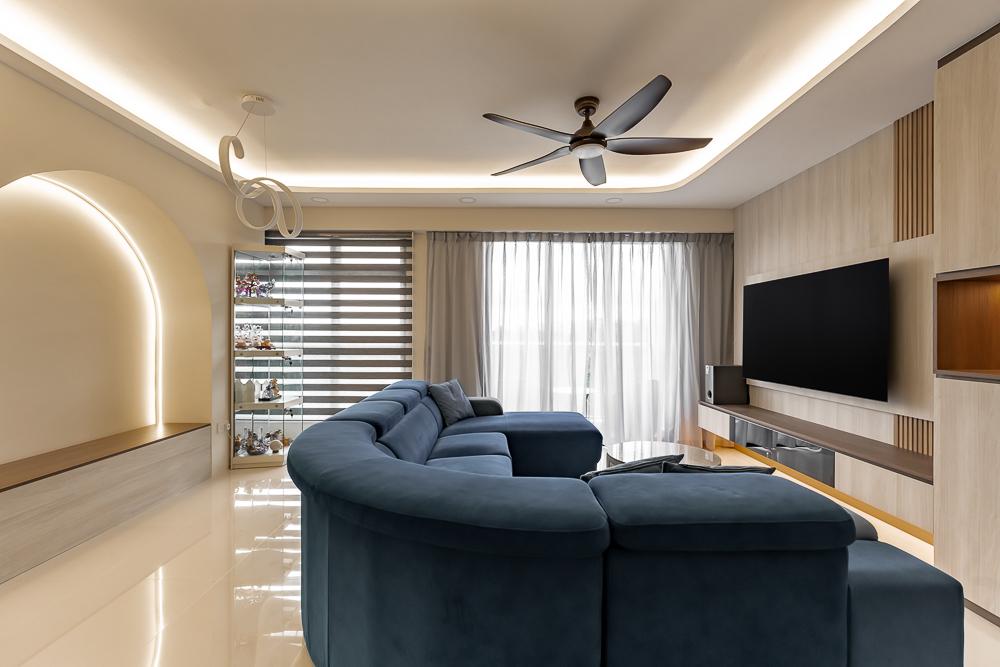

Seng Kang 1 ($88,000) by Studio 65
- Sectional sofas and modular seating: Modular sofas allow you to add or remove sections based on your guest count. A sectional with a chaise or detachable ottoman can be reconfigured to make room for more guests or provide extra seating. This way, you can set up a cozy, lounge-style environment for casual gatherings or keep the sofa compact for day-to-day use.
- Foldable or extendable dining tables: A foldable or extendable dining table is a lifesaver for hosting. Choose a table that expands when you have guests but folds away compactly afterward. This allows you to have a full dining setup without a permanent large table taking up space.
- Convertible sofa beds: If your apartment doubles as a guest space, a sofa bed can transform your living area into an extra bedroom. Many sofa beds today offer stylish designs that don’t compromise on comfort, making them an excellent choice for homes where space is tight.
- Stackable or foldable chairs: Keep a set of stylish, foldable chairs that can be stored away when not in use. These are especially useful for parties or larger gatherings, as they provide extra seating without adding permanent bulk to your space.
Smart Storage Solutions
Clutter can quickly overwhelm a small area, so incorporating clever storage options is key to keeping a hosting-friendly home organized and welcoming.
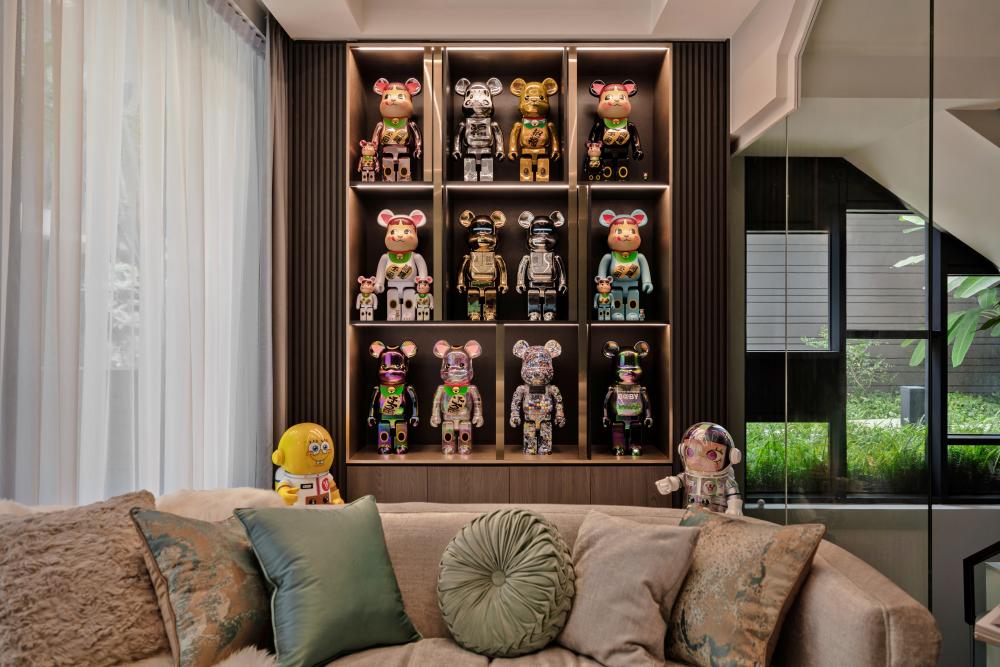

Alana 1 ($92,000) by Mr Shopper Studio
- Built-in cabinets and shelving: Built-in cabinetry can be customized to fit your space and store items you want close at hand but out of sight, like board games, serving ware, and extra linens. Floating wall shelves are also great for displaying decorative items or everyday essentials, keeping the floor space clear.
- Storage ottomans and benches: Multi-functional furniture like storage ottomans and benches serve double duty as seating and storage. Use them to stow away items you might need during gatherings, such as extra throw blankets, pillows, or magazines. These pieces can also be easily moved around, adding versatility to your hosting setup.
- Wall-mounted solutions: Wall-mounted storage is perfect for maximizing vertical space. Consider wall-mounted wine racks, hooks for hanging bags and coats, or even magnetic strips for kitchen tools. These free up floor space and make frequently used items easy to access.
- Hidden storage: Look for coffee tables or side tables with hidden storage compartments. They’re ideal for tucking away small items, such as remotes, coasters, or chargers, ensuring that your living room looks tidy at a moment’s notice.
- Clear bins and labeling systems: To avoid rummaging for items during gatherings, use labeled bins or baskets in cupboards or closets. Transparent storage solutions make it easy to spot items quickly, allowing you to easily retrieve what you need when hosting guests.
Embrace an Open Kitchen Concept
Regardless of whether you enjoy cooking or prefer getting takeout when you host, the kitchen is a key space where guests tend to congregate.
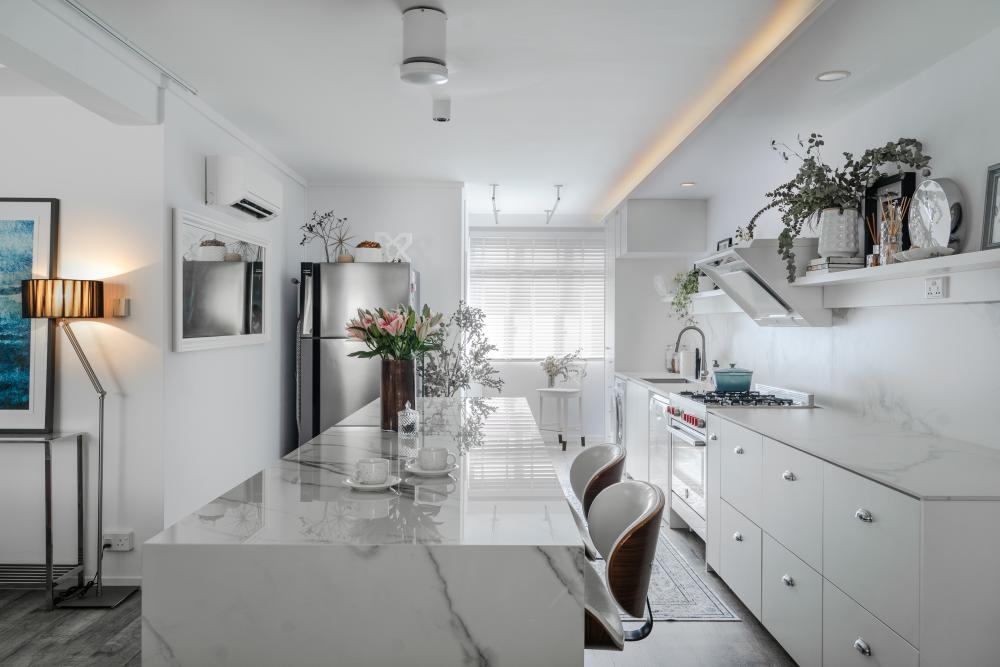

Blk 939 Tampines ($80,000) by Homies Design
An open kitchen concept allows you to prep, cook, or serve drinks while still being part of the conversation. It encourages interaction and ensures that everyone can easily access food and drinks, making it a natural gathering spot during any event.
- Dry Kitchen Setup: Dry kitchens are an excellent choice for entertaining, as they provide easy access to drinks, snacks, and other items. While your main kitchen is busy with cooking and getting hot or oily, your guests can help themselves to drinks and snacks without disrupting the cooking process. This keeps the main kitchen area clear and ensures that guests can enjoy appetizers and refreshments in a convenient spot.
- Wine Fridge or Beverage Cooler: If you don’t have enough space for a dry kitchen, another option is to get a wine fridge or beverage cooler to keep drinks chilled and easily accessible. Guests can help themselves to a cold drink without having to wait for you to grab it from the main fridge, and it also keeps the main fridge from getting overcrowded with beverages.
- Maximize Your Countertop Space: An extended counter can be used for meal prep or as a buffet area for serving appetizers. If you have a breakfast bar, it can double as an extra food prep area during parties or gatherings. The more flexible your counter space, the easier it will be to manage food preparation and serving at the same time.
- Flexible Seating: Consider adding flexible seating to your kitchen area, such as stools around a kitchen island or bar counter. This encourages socializing while you’re cooking or preparing food, and it gives guests a place to sit and chat without feeling like they’re in the way. If space is tight, you can opt for stackable or foldable stools that can be stored away when not in use.
- Concealed Storage for Clutter-Free Look: Hidden storage is key to keeping the kitchen looking sleek, especially if it’s part of an open layout. Conceal appliances like the toaster or coffee machine when not in use to maintain a clean, cohesive look.
Use Flexible Lighting to Set the Mood
Lighting plays a crucial role in creating a welcoming atmosphere. Layered lighting options allow you to adapt the ambiance to different occasions, making your home feel cozy and versatile.
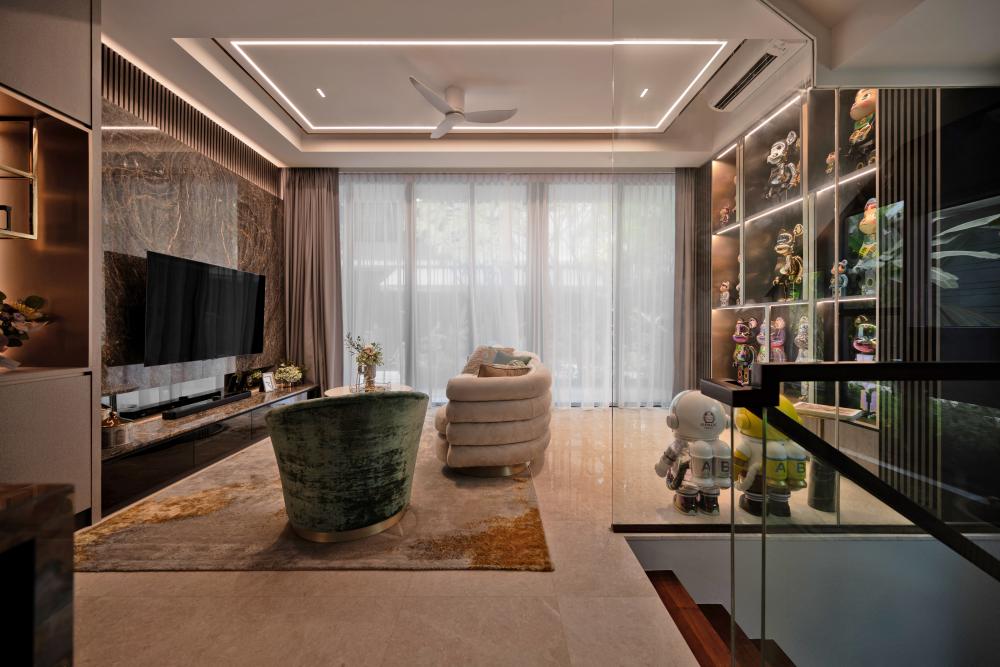

18A Circuit Road ($95,000) by Starry Homestead Pte Ltd
- Layered Lighting Options: Include a mix of ceiling lights, wall sconces, and table lamps. This allows you to adjust the lighting for different activities, from bright lighting for meals to softer lighting for intimate gatherings.
- Accent Lighting for Key Areas: Add warm accent lights in seating and dining areas to create an inviting glow. For example, LED strips under cabinets or behind shelves add a stylish touch while also serving a practical purpose.
- Dimmer Switches for Adjustability: Install dimmer switches to easily adjust lighting intensity based on the occasion. Dimmable lights are perfect for transforming the vibe from bright and energetic to soft and cozy.
Design Your Dining Area
A well-designed dining area plays a crucial role in hosting, creating a space where guests can gather and enjoy meals in comfort.
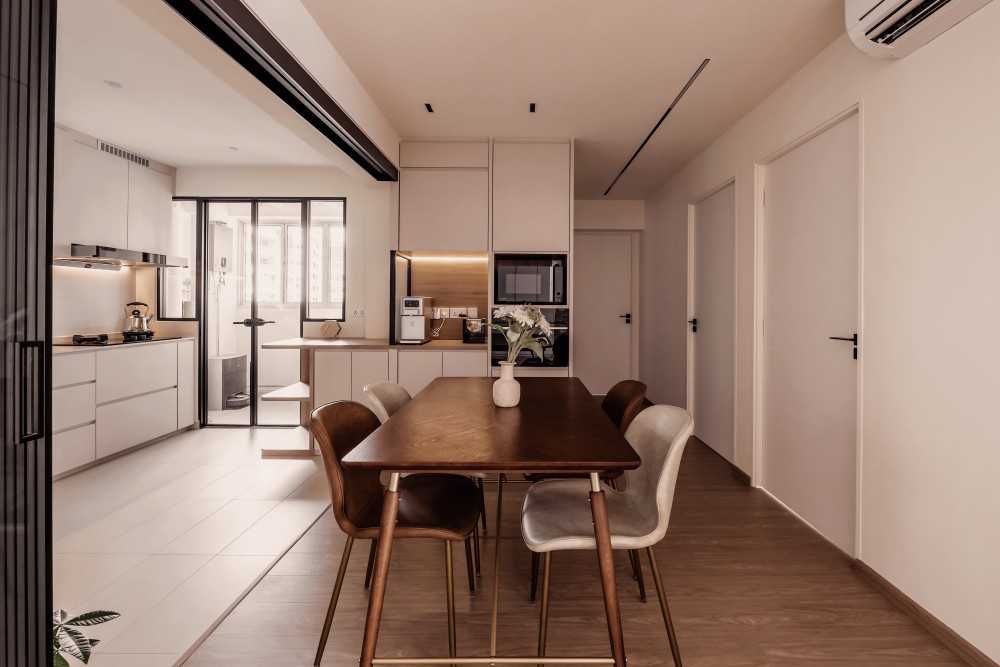

369 Holland Road ($100,000) by Weiken.com Design Pte Ltd
Whether you’re preparing a multi-course meal or a family-style meal, it’s essential to have practical solutions that allow for seamless interaction, easy serving, and a comfortable dining experience.
- Self-Serve Station: Set up a small station near the dining table for essentials like carafes of water, napkins, and extra cutlery, so guests can easily help themselves. This doesn’t have to be a large piece of furniture; a compact console table or even a small, movable IKEA trolley works well for storing necessities without taking up much space.
- Wine Bar or Drink Station: Instead of letting drinks clutter the dining table, consider setting up a small wine or drink station on a countertop, kitchen island, or bar cart. This can hold everything from wine glasses to mixers and garnishes, keeping the dining area clear for food. This setup allows guests to pour their drinks at their convenience and creates an interactive experience, especially if you offer a signature cocktail or wine pairing for the evening.
- Designate a Centralized Trash Area: When hosting a dinner party, especially with disposable plates or utensils, it’s important to provide a centralized trash area for guests to easily dispose of their items. Make sure this space is easily accessible but discreet, so it doesn’t detract from the ambiance of your gathering. Use a larger, sleek trash bin with a lid, or a simple waste station tucked in a corner near the dining area or kitchen.
Playdates & Family Gatherings
When hosting playdates or family gatherings, the focus shifts to making the space both kid-friendly and welcoming for adults.
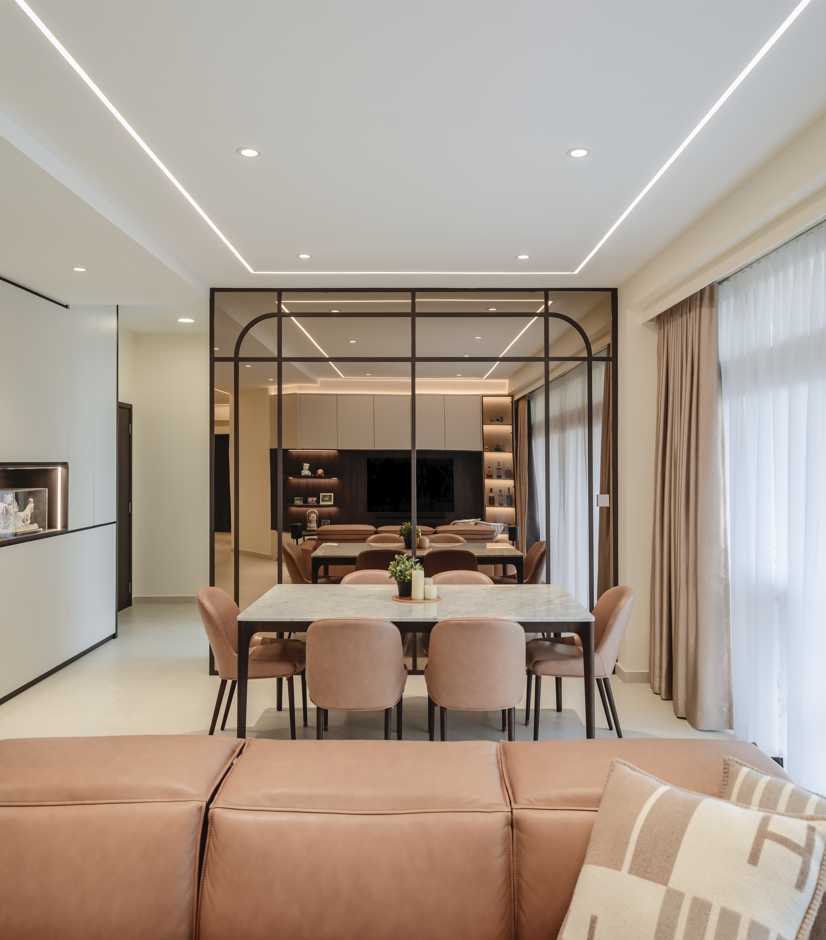

870 Tampines ($78,000) by The Interior Lab Pte Ltd
With small children running around, you need a flexible layout that accommodates toys, play areas, and seating for adults to chat and relax.
- Kid-Friendly Storage: For those who frequently host playdates, consider using open storage bins or a toy organizer within easy reach of the main living area. Kids can access toys easily, and clean-up will be quick when the playdate wraps up.
- Extra Storage for Toys and Belongings: With kids running around, there will be toys, bags, and personal belongings scattered everywhere. Have a designated area or bin where guests can store their belongings, including diaper bags, shoes, and jackets. Toy storage bins or baskets placed in the play area can help quickly gather and tidy up items as needed, keeping the space clutter-free and functional for everyone.
- Soft, Durable Seating: Use durable, easy-to-clean upholstery and add soft floor cushions or rugs, so kids have a safe, comfortable place to play. Parents can relax while kids play within sight, creating a relaxed environment for everyone.
- Easy Access to Snacks and Drinks: A family gathering often involves a lot of snacking and casual eating throughout the day. Set up a snack station that’s accessible to both kids and adults, like a small countertop or a snack table with bowls of fruits, nuts, and crackers. For little ones, consider having a lower shelf or table where they can independently grab their snacks. For drinks, keep a cooler or a small drink station with water, juice, and other beverages so guests can easily refill without interrupting the fun.
Casual Get-Togethers and Movie Nights
Casual get-togethers, from spontaneous hangouts to movie nights, call for a relaxed, laid-back atmosphere where comfort and convenience are key.
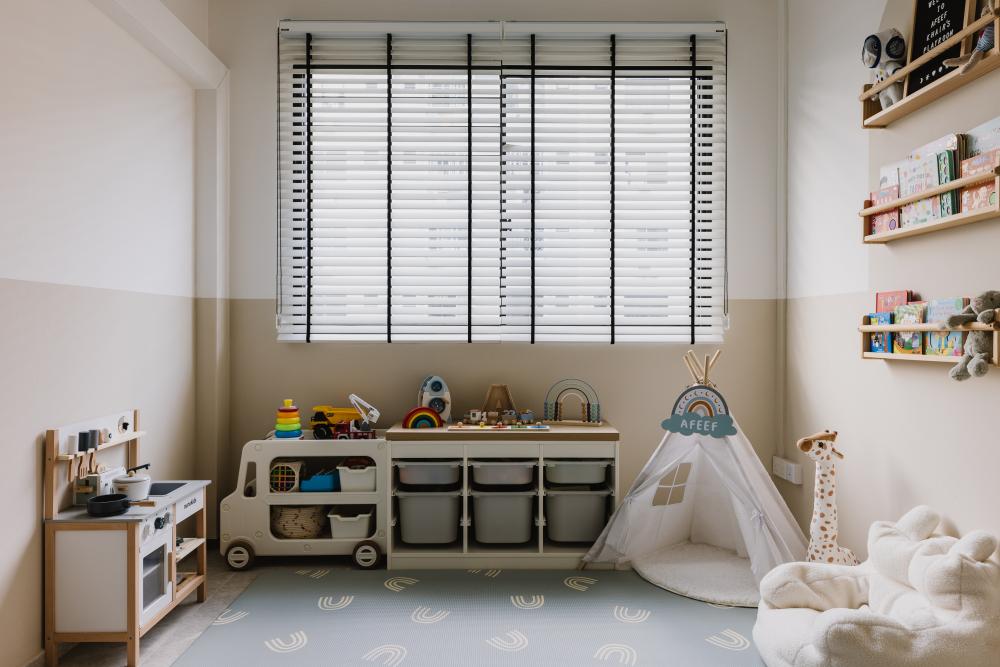

870 Tampines ($78,000) by The Interior Lab Pte Ltd
You want to create a space where everyone can easily mingle, share snacks, and enjoy each other’s company without feeling crowded.
- Comfortable Seating for Everyone: For a casual get-together or movie night, comfort is key. Use cozy seating arrangements like plush sofas, bean bags, and floor cushions to create a relaxed atmosphere. If you’re limited on space, consider modular seating that can be moved around to suit the number of guests. A few oversized pillows or throws on the floor can make the space feel inviting and perfect for lounging.
- Maximize Screen Viewing Comfort: For a true movie night experience, make sure everyone has a good view of the screen. If you have limited seating, be sure to place chairs or cushions where guests can comfortably see the screen without straining their necks. If you don’t have a TV, consider setting up a projector for a more cinematic feel. You can even use a blank wall for an impromptu movie theater experience.
- Mood Lighting: The right lighting is essential for creating a relaxed atmosphere for movie nights. Use soft, ambient lighting rather than bright overhead lights. Consider string lights, floor lamps, or dimmable table lamps to set the mood. If possible, install smart lighting that allows you to adjust the brightness easily without getting up. You can even place a few candles (real or LED) around the room for added warmth.
- Have Extra Chargers and Charging Stations: Guests often come with their phones in hand, and it can be frustrating if they run out of battery mid-event. Make sure to have a charging station or extra chargers available so that guests can easily power up their devices. You can set up a designated area with charging cables or have portable power banks on hand, which will keep everyone content and connected.
BONUS: Should you host guests on your balcony?
Balconies can be an inviting space for hosting guests, offering a fresh outdoor atmosphere that indoor settings sometimes lack. However, whether your balcony is suitable for entertaining largely depends on its size, layout, and your home’s general design.
Consider the Space
In general, Singapore’s balconies tend to be quite small. For HDB flats, the size of the balcony varies depending on whether you’re staying in a resale flat or a new flat, with newer flats tend to having smaller balconies.
In condominiums, the size of the balcony can differ based on the unit type and floor level. Ground-floor units and 3-bedroom (or larger) units typically offer more spacious balconies. However, for those in 1-bedroom or 2-bedroom condominiums, balconies tend to be much smaller, which can limit your hosting options.
Ambiance and Comfort
Creating a welcoming environment on your balcony requires some thought. Adding comfortable seating, outdoor lighting, and perhaps some potted plants can turn a simple outdoor space into a charming venue.
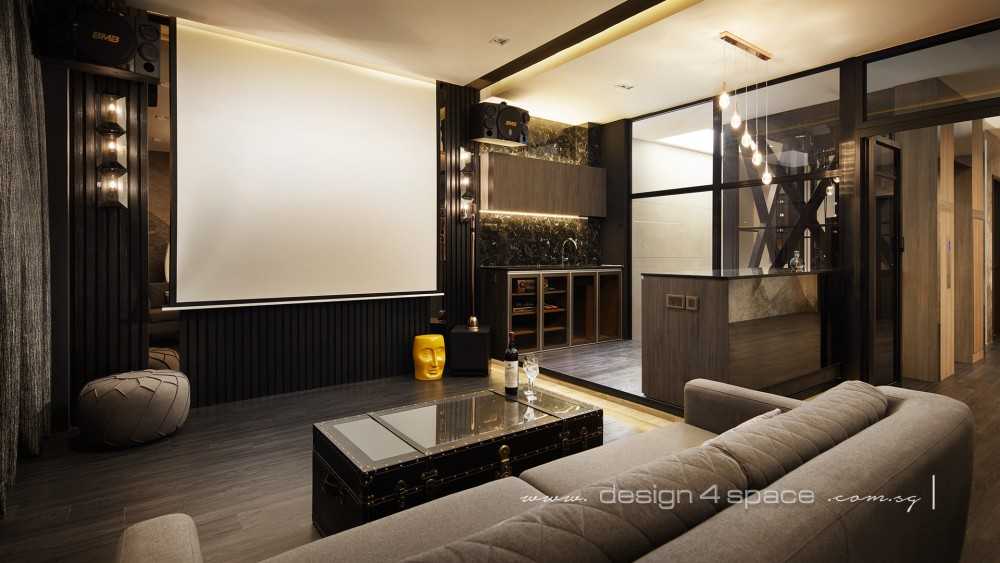

Sembawang Hill Real Estate ($85,000) by Design 4 Space Pte Ltd
One way to improve comfort is by installing Ziptrak outdoor blinds, which allow you to enclose your balcony and protect guests from rain or excessive sun. Ziptrak systems are a great way to create a more controlled environment, making your balcony feel like an extension of your indoor living space.
The Right Time of Day
Daytime gatherings on your balcony may not always be ideal, particularly given Singapore’s hot and humid weather. However, if you’ve got Ziptrak installed and are able to turn on your air conditioning inside your house, you can effectively transform your balcony into an enclosed, more comfortable space. That said, if you opt to lower the Ziptrak and keep the air conditioning running, you’ll lose the view, so consider whether this trade-off works for your event.
Hotpot and Grilling on Your Balcony
If you do have a large enough balcony, this is a great space for enjoying hotpot or grilling, as it helps to keep your indoor area free from lingering smells and smoke.
When cooking on the balcony, the open air allows steam, smoke, and odors to dissipate quickly, preventing them from seeping into your living space. This is especially useful in Singapore’s humid climate, where grilling or hotpot indoors can make your home feel stuffy or uncomfortable.
Just make sure you have plenty of cold drinks on hand, so your guests won’t get too warm while enjoying the outdoor feast!
A Final Word on Designing a Home That’s Perfect For Hosting
Designing a home for hosting in Singapore’s compact apartments requires thoughtful planning and strategic design choices.
From selecting an ideal apartment layout and creating multi-functional living spaces to embracing smart storage and flexible seating, every element plays a role in making your home inviting and functional for gatherings.
Additionally, considering practical yet stylish décor, low-maintenance materials, and specialized spaces for different hosting needs ensures a comfortable and stress-free environment for both hosts and guests.
By incorporating these tips, even small spaces can be transformed into welcoming venues for any occasion, allowing you to entertain with ease and style.
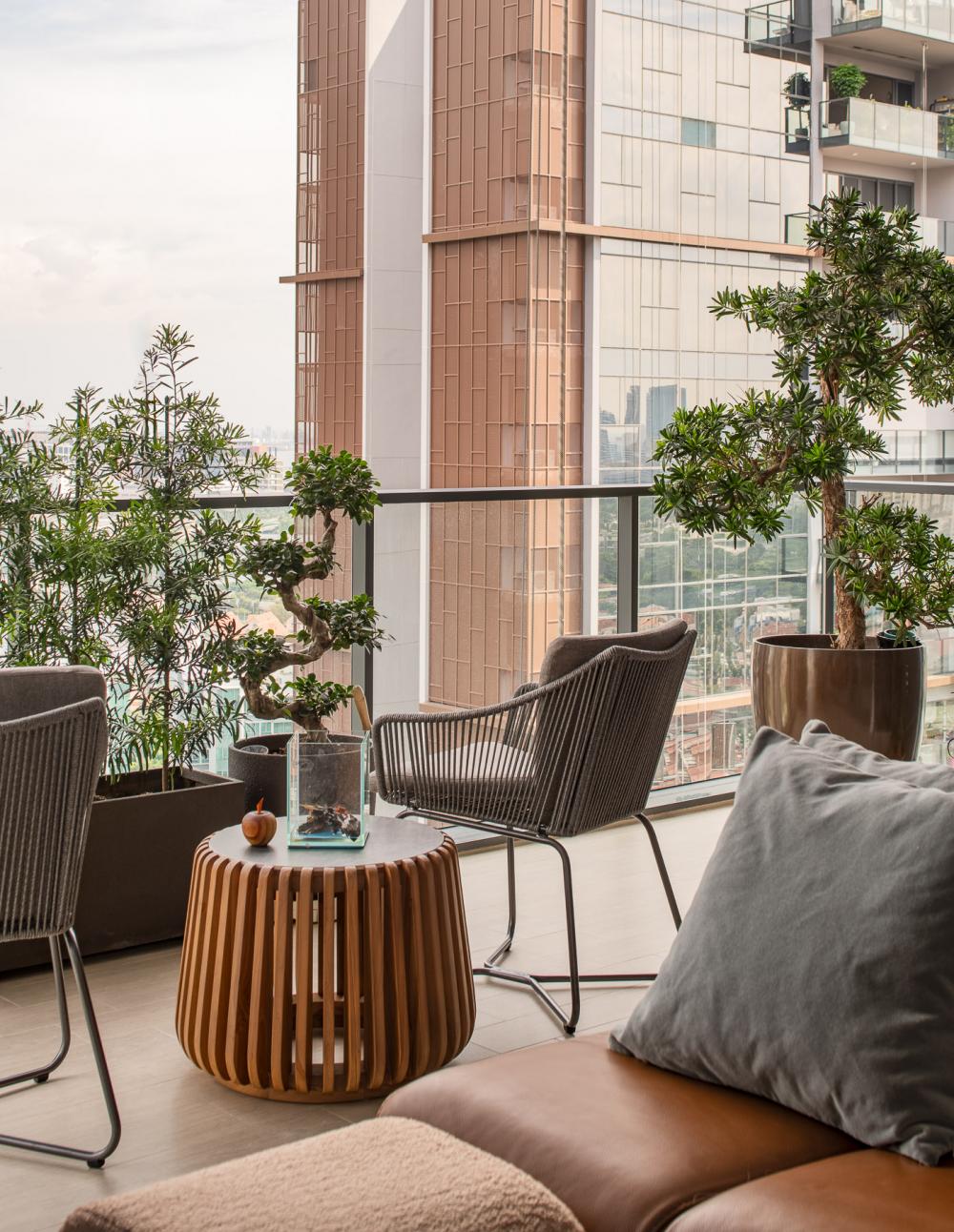

123B Tengah Dr ($85,000) by Mr Designer Studio
- Popular Air-Purifying Plants: Choose plants known for their air-purifying qualities, such as snake plants and spider plants. These plants are said to be effective at removing toxins and can thrive in indoor environments with minimal maintenance.
- Placement: Place air-purifying plants in areas where you spend the most time, such as the living room, bedroom, or home office. Grouping several plants together can enhance their effectiveness in improving air quality.
- Care: Ensure proper care by providing adequate light, watering as needed, and regularly removing dust from the plant leaves to maintain their air-purifying benefits.
Incorporating air-purifying plants helps create a fresher, healthier indoor environment while adding natural beauty to your space.
Using Air Purifiers
Air purifiers are another effective tool for enhancing indoor air quality, especially in areas with higher levels of dust, allergens, or pollution.
- Choosing the Right Air Purifier: Select an air purifier with a HEPA filter, which is effective at trapping airborne particles such as dust, pollen, and pet dander. Consider the size of the room and choose a purifier with adequate coverage for the space.
- Placement: Position air purifiers in commonly used areas or rooms where air quality is a concern. Place them in central locations to ensure optimal air circulation and purification.
- Maintenance: Regularly clean and replace filters according to the manufacturer’s instructions to ensure the air purifier continues to function effectively.
- Using air purifiers helps reduce airborne contaminants and maintain a cleaner, healthier indoor environment.
Ensuring Proper Ventilation
Proper ventilation is essential for maintaining good air quality and preventing issues such as excess moisture and stale air.
- Ventilation Systems: Install or upgrade ventilation systems, such as placing fans in the kitchen and bathroom to remove excess moisture and odors. Ensure that ventilation systems are properly maintained and cleaned regularly.
- Natural Ventilation: Take advantage of natural ventilation by opening windows and doors to allow fresh air to circulate. Use window screens to keep out insects while allowing airflow.
- Cross-Ventilation: Create cross-ventilation by opening windows on opposite sides of a room or building. This technique helps promote airflow and improves air circulation throughout the space.
Effective ventilation helps prevent indoor air quality issues and keeps your home feeling fresh and comfortable.
Managing Humidity Levels
In Singapore, dealing with high humidity is a constant challenge, as it often makes the temperature feel warmer than it actually is.
Properly managing indoor humidity levels is crucial for maintaining comfort and preventing issues such as mold growth and dampness. By controlling humidity, you can create a more pleasant living environment and mitigate the effects of Singapore’s humid climate.
- Dehumidifiers: Use dehumidifiers to reduce excess moisture in areas prone to high humidity, such as bathrooms, kitchens, and laundry rooms. Choose a dehumidifier with a suitable capacity for the size of the space to effectively manage humidity levels and prevent mold growth.
- Air Conditioning: Utilize air conditioning to help regulate indoor humidity. Air conditioners not only cool the air but also remove moisture, which can make indoor environments more comfortable and less humid.
Managing humidity levels helps create a more comfortable and healthy living environment by preventing moisture-related issues and maintaining balanced air quality.
A Final Word on Designing a Sensory-Friendly Home
Designing a sensory-friendly home is all about creating a space that promotes comfort, calm, and well-being for everyone.
By focusing on soothing colours, textures, lighting, and minimizing clutter, you can create a home that’s not only functional but also feels like a peaceful retreat. Whether you’re accommodating sensory sensitivities or simply looking for a more serene environment, these design principles can transform your home into a sanctuary of comfort and calm.
Want to check out home renovation projects for more inspiration? Browse interior design ideas on Hometrust, or click the button below to get connected with expert designers!
Renovating soon? Let Hometrust recommend the best interior designers.
If you are reading this, you are probably wondering how you can create your dream home.
Here’s the thing, everyone’s needs and requirements for their home renovation is different. A designer that may work for someone else, may not quite work for you.
At Hometrust, we’re here to help match top rated designers, recommended by past homeowners to you through our data-driven and matching algorithm.
Whether you are looking for partial renovation or a full fledge overhaul, we’ll be able to recommend you top designers to match your renovation requirements and lifestyle.
Recommendations and free and you can simply start by helping us understand your needs below!
Get RecommendationsRenovate safe!
The Hometrust Team

